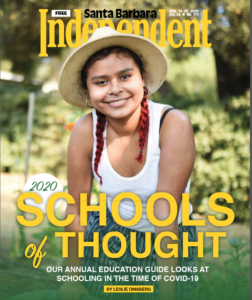
Schools of Thought introduction, originally published in the November 19, 2020 issue of Santa Barbara Independent.
Hope Ranch Campus Provides Proper Home for Project-Based Learning
Sometimes it’s all in the timing. Take Laguna Blanca’s new Center for Science and Innovation, the school’s first major facility addition in at least 20 years.
“We decided to go forward with construction on March 11 of this year, and two days later we were closing school because of the pandemic,” said Head of School Rob Hereford.
Plans for the 5,500 square feet of modern, dedicated space have been in the works since 2014, a drought year where the first big rains damaged the chemistry lab. They did a short-term fix, but Hereford knew it was past time to do some real improvements.
“When I give tours to people who were here back in the ’50s and ’60s, and they say, ‘Oh, it looks just like when I was here as a student,’” said Hereford. “That is comforting on one level, but a little disturbing if you’re trying to teach chemistry in the 21st century.”
Working with the school’s buildings and grounds committee, KBZ Architects, and the science department, the team settled on renovating two older existing locker rooms that had morphed into what Hereford called “the campus junk drawer, where anything we didn’t know what to do with we would just throw it into that space.” But the size was right, and there was already plumbing, which would be needed for lab space. One of the “odd advantages” of having closed the campus for so many months is that the project — which
includes biology and chemistry labs, a STEM Research and Innovation Lab, outdoor research areas, a physics lab, and a teacher innovation lab, which gives teachers from different grades and disciplines a space for collaboration — is now on schedule to open sometime in January 2021.
“We had an outstanding science program, and we were doing it in spite of our mediocre facilities,” said Hereford. “This allows us to have really up-to-date facilities that we can grow into. There is space for teachers to be able to do more and expand the programs in ways that are really going to be terrific. When I think of what we’ve been able to pull off in these substandard facilities, it’s exciting to think about what our teachers will be able to do in these brand-new spaces.”
Originally published in the Santa Barbara Independent on November 19, 2020. To read the section as it appeared in print, please click here.






